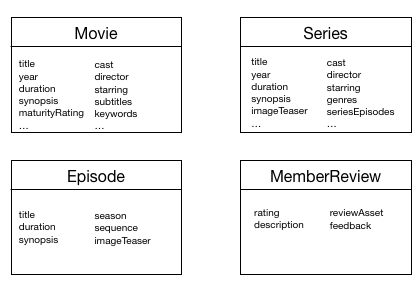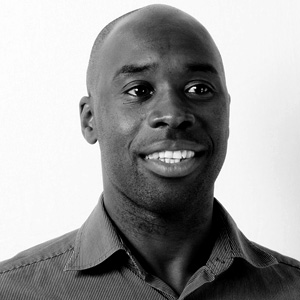Design Content Model
The conceptual content model is a great conversation starter for content. It’s a wonderfully simple boxes and lines diagram of your content and their inter-relationships on a single page. So, armed with your one pager, a content model makes content accessible to the masses. It’s your content pocket map you reach for to quickly understand the size, scope and complexity of content. And in doing so, content models enable many more people to challenge, accept, refute and collaborate on the structure and meaning of content. Now we need to progress onto the design content model.
Conceptual Content Model
Content types have attributes. What are they? Content types have relationships. How do content types relate to one another? For the last couple of years, we’ve run a workshop where we create a simple content model for Netflix. We start by mining out a few content types, and gradually add more detail. In the workshop slides, we work through the Netflix site and throw down some content types.

The conceptual content model above is a great start. You can see on one page the key content types for Netflix. To get these, we logged into Netflix and poked around a bit. We look at the listings, jotted down a few candidate content types (e.g. Movie, Reviews, Series, Video, HeroBannar) as part of a brainstorm phase. No right or wrong answers. Then we rationalised them down into a critical few and showed how they related to one another. So we noticed that movies and series had reviews. Series have episodes. Movies and series were related somehow. That’s it. So we pulled this together into the conceptual content model above as our first step. Now, it’s time to walk the floor and put it front of everyone in a position to listen.
Design Content Model
Next we start adding a few attributes to each of the key content types. The goal here is to put a bit more meat on the bone. To get a bit more detail around the essential characteristics of each content type in our conceptual content model. So back to the Netflix website to look at each content type. What makes up a Movie? A MemberReview. An Episode. We list all the key attributes for each content type and walk the floor again to see what people think.

Relationships
And finally, relationships. Here, we focus our attention on how content types relate to each other by asking more questions:
- Can an episode exist without an Series?
- Do movies have related series and/or other movies?
- When movies expires, should their reviews live on?
- Do the same member rules hold for series?
- Can a movie be a part of a series?
- Are actors and actresses important in this model?
Questions, questions and more questions. And they’ll be many more. This is just the start. We have just entered the design phase of content modelling. We have to be curious. Asking questions to get answers. To solve problems and reflecting all this back as part of the shared view of content. A content model is a communication vehicle. Content modelling is the means to maintain that conversation between all interested parties. We pull together everything we’ve learnt about attributes, content items and relationships to create this design content model.

Looking at this Netflix design content model, you can see that we have strengthened a number of key relationships. Series own episodes meaning that episodes cannot exist without a Series. When the series dies, so do all the episodes. This is the not the case for member reviews. Instead, member reviews can live on even when movies and series expire. These are key business decisions help inform the how other downstream parties work with the content. With a content model, your content, its structure and meaning, are both is visible and accessible.
Summary
The design content model is where the rubber really hits the road. It’s where we zoom in and inspect the content model from multiple perspectives. Different teams of people will have different content needs to consider. How do we best structure the content to meet those needs? We go through all this in detail during our workshop, capturing the key parts in slideware.
Next Steps
Where next? One more step towards the technology: the implementation content model.
- Content Models
- Conceptual Content Model
- Design Content Model (this page)
- Implementation Content Model
- Design Guidelines for Content Models
